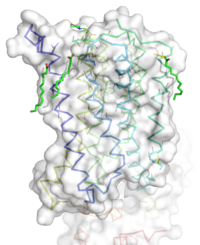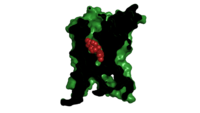Sandbox Reserved 1160
From Proteopedia
(Difference between revisions)
| Line 1: | Line 1: | ||
== Human metabotropic glutamate receptor 5 transmembrane domain == | == Human metabotropic glutamate receptor 5 transmembrane domain == | ||
<StructureSection load='4oo9' size='300' frame='true' side='right' caption='Human metabotropic glutamate receptor 5 transmembrane domain' scene='72/721531/Protien_clean_sce/1'> | <StructureSection load='4oo9' size='300' frame='true' side='right' caption='Human metabotropic glutamate receptor 5 transmembrane domain' scene='72/721531/Protien_clean_sce/1'> | ||
| - | Receiving and responding to extracellular messages is critical to the proper function of the nervous system. Glutamate is the primary excitory neurotransmitter of the CNS, and metabotropic glutamate receptor 5 will play a major role in glutamate signaling<ref name="Dore" />. Metabotropic glutamate receptor 5 transmembrane domain is a homodimeric [[GPCR]] that resides in the cellular membrane <ref name="Dore" />. This domain is a member of the Class C GPCR family and can further be categorized into the Group I subgroup<ref name="Wu" />. The transmembrane domain will signal through a Gq/11 pathway<ref name="Dore" />. mGlu5 will bind glutamate to the extracellular Venus flytrap domain and the signal will be transduced across the membrane to a heterotrimeric G protein, which will ultimately lead to calcium release and the activation of [[PKC]]<ref name="Wu" />. This will elicit a excitory post-synaptic response and modulate long term potentiation<ref name="Wu" />. Human metabotropic glutamate receptor 5 is found throughout the central nervous system. Areas containing high concentrations of this protein are often involved in emotional processing and higher cognition<ref name="Niswender" />. The localization of mGlu5 in the CNS and the presence of multiple domains makes mGlu5 an excellent target for treating schizophrenia,[http://www.fragilex.org/fragile-x/fragile-x-syndrome/ Fragile X], depression, anxiety, and Alzheimer's disease<ref name="Wu" />. | + | Receiving and responding to extracellular messages is critical to the proper function of the nervous system. Glutamate is the primary excitory neurotransmitter of the Central Nervous System (CNS), and metabotropic glutamate receptor 5 will play a major role in glutamate signaling<ref name="Dore" />. Metabotropic glutamate receptor 5 transmembrane domain is a homodimeric [[GPCR]] that resides in the cellular membrane <ref name="Dore" />. This domain is a member of the Class C GPCR family and can further be categorized into the Group I subgroup<ref name="Wu" />. The transmembrane domain will signal through a Gq/11 pathway<ref name="Dore" />. mGlu5 will bind glutamate to the extracellular Venus flytrap domain and the signal will be transduced across the membrane to a heterotrimeric G protein, which will ultimately lead to calcium release and the activation of [[PKC]]<ref name="Wu" />. This will elicit a excitory post-synaptic response and modulate long term potentiation<ref name="Wu" />. Human metabotropic glutamate receptor 5 is found throughout the central nervous system. Areas containing high concentrations of this protein are often involved in emotional processing and higher cognition<ref name="Niswender" />. The localization of mGlu5 in the CNS and the presence of multiple domains makes mGlu5 an excellent target for treating schizophrenia,[http://www.fragilex.org/fragile-x/fragile-x-syndrome/ Fragile X], depression, anxiety, and Alzheimer's disease<ref name="Wu" />. |
== Discovery == | == Discovery == | ||
| - | The mGlu family of receptors was the first of the Class C GPCR to be extensively studied<ref name="Wu" />. The first regions of the protein crystallized and studied were the Venus | + | The mGlu family of receptors was the first of the Class C GPCR to be extensively studied<ref name="Wu" />. The first regions of the protein crystallized and studied were the Venus Fly Trap domain and the cystiene-rich domain on the extracellular region of the receptor<ref name="Dore" />. The hydrophobic nature and flexibility of the transmembrane domain made it difficult to crystallize. Recently, the human metabotropic glutamate receptor 5 transmembrane domain (TMD) was crystallized and a structure elucidated<ref name="Dore" />. There were several necessary modifications made to the TMD for it to successfully crystallize. The protein was thermostabilized and flexible domains were removed<ref name="Dore" />. In total residue 2-568 and residues 837-1153 were excised from the structure. Also, a T4 -<scene name='72/721531/Protien_lys/1'>Lysozyme</scene> was inserted into ICL-2 to add stability<ref name="Dore" />. |
== Structure== | == Structure== | ||
[[Image:STR.png|200 px|left|thumb|Overall Structure of the TMD. The polar heads on the Oliec acids orient the protein with the top of the image being the extracellular portion of the protein, the middle portion inserted into the membrane, and the lower portion located inside of the cell. ]] | [[Image:STR.png|200 px|left|thumb|Overall Structure of the TMD. The polar heads on the Oliec acids orient the protein with the top of the image being the extracellular portion of the protein, the middle portion inserted into the membrane, and the lower portion located inside of the cell. ]] | ||
=== Overview === | === Overview === | ||
| - | The mGlu5 TMD contains 7 <scene name='72/721531/Protien_7_helices/2'> alpha helices</scene> that | + | The mGlu5 TMD contains 7 <scene name='72/721531/Protien_7_helices/2'> alpha helices</scene> that spans the membrane. The protein was crystallized with Oleic acid and MES. On the superior portion of the protein there are several critical extracellular loops. The binding pocket can be found near the middle of the protein. Inserted into the biding pocket is the negative allosteric modulator [http://www.en.wikipedia.org/wiki/Mavoglurant mavoglurant]. It is important to note that the TMD as illustrated is in an inactive conformation. On the intracellular portion of the protein there exist several ionic locks whose positions will determine the activity of the protein. |
=== Extracellular Domain === | === Extracellular Domain === | ||
These are the <scene name='72/721532/Ecl_trail_1/7'>Extracellular Loops</scene> with extracellular loops (ECLs) 1, 2, and 3 highlighted in purple. Additionally in the ECL domain, a <scene name='72/721532/Ecl_trail_1/6'>disulfide bond</scene> is attached to both Helix 3 and the amino acid chain between Helix 5 and the N terminus. The disulfide bond is highlighted in yellow, and it is conserved in all classes of glutamate receptor 5 transmembrane domains<ref name="Wu" />. | These are the <scene name='72/721532/Ecl_trail_1/7'>Extracellular Loops</scene> with extracellular loops (ECLs) 1, 2, and 3 highlighted in purple. Additionally in the ECL domain, a <scene name='72/721532/Ecl_trail_1/6'>disulfide bond</scene> is attached to both Helix 3 and the amino acid chain between Helix 5 and the N terminus. The disulfide bond is highlighted in yellow, and it is conserved in all classes of glutamate receptor 5 transmembrane domains<ref name="Wu" />. | ||
| Line 27: | Line 27: | ||
== Pathway == | == Pathway == | ||
| - | It all begins with glutamate binding to the Venus flytrap domain. The signal is transduced across the cystine-rich domain to the TMD<ref name="Niswender" />. Next, the dimerization of the TMD occurs. This activates the Gq/11 pathway, which activates | + | It all begins with glutamate binding to the Venus flytrap domain. The signal is transduced across the cystine-rich domain to the TMD<ref name="Niswender" />. Next, the dimerization of the TMD occurs. This activates the Gq/11 pathway, which activates phospholipase Cβ<ref name="Niswender" />. The active [http://www.proteopedia.org/wiki/index.php/2zkm phospholipase Cβ] hydrolyzes phosphotinositides and generates [https://pubchem.ncbi.nlm.nih.gov/compound/439456#section=Top inositol 1,4,5-trisphosphate] and [http://www.sivabio.50webs.com/ip3.htm diacyl-glycerol]<ref name="Woodcock" />. This results in calcium mobilization and activation of PKC<ref name="Niswender" />. |
== Disease == | == Disease == | ||
Revision as of 15:55, 30 March 2016
Human metabotropic glutamate receptor 5 transmembrane domain
| |||||||||||


